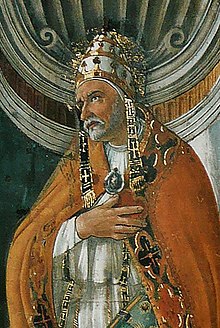Pope Sixtus II
Sixtus II | |
|---|---|
| Bishop of Rome | |
 Fresco of Pope Sixtus II bySandro Botticelliin theSistine Chapel. | |
| Church | Early Church |
| Papacy began | 31 August 257 |
| Papacy ended | 6 August 258 |
| Predecessor | Stephen I |
| Successor | Dionysius |
| Personal details | |
| Born | Unknown Greece,Roman Empire |
| Died | 6 August 258 Rome, Roman Empire |
| Sainthood | |
| Feast day | 6/7 August |
| Venerated in | Catholic Church, Eastern Orthodox Church |
| Other popes named Sixtus | |
Pope Sixtus II(Greek:Πάπας Σίξτος Β΄), also written asPope Xystus II,wasbishop of Romefrom 31 August 257 until his death on 6 August 258. He was killed along with sevendeacons,includingLawrence of Rome,during thepersecution of Christiansby theEmperor Valerian.[1]
Life[edit]
According to theLiber Pontificalis,he was aGreek,[2]born in Greece, and was formerly a philosopher.[3]However, this is uncertain, and is disputed by modern Western historians arguing that the authors ofLiber Pontificalisconfused him with the contemporary author Xystus, who was a Greek student ofPythagoreanism.[1]
Sixtus II restored the relations with the African and Eastern churches, which had been broken off by his predecessor over the question ofhereticalbaptismraised by the heresyNovatianism.
In the persecutions under theEmperor Valerianin 258, numerous bishops, priests, and deacons were put to death. Pope Sixtus II was one of the first victims of this persecution, beingbeheadedon 6 August. He was martyred along with six deacons: Januarius, Vincentius, Magnus, Stephanus,Felicissimus and Agapitus.[1]Lawrence of Rome, his best-known deacon, suffered martyrdom on 10 August, four days after his bishop.[4]
Sixtus is thought by some to be the author of thepseudo-CyprianicwritingAd Novatianum,though this view has not found general acceptance. Another composition written at Rome, between 253 and 258, is generally agreed to be his.
Legacy[edit]
Sixtus II is referred to by name in theRoman Canonof theMass.[1]TheTridentine calendarcommemorated Sixtus, Felicissimus, and Agapitus on the feast of theTransfiguration of the Lord,6 August. They remained in that position in theGeneral Roman Calendaruntil 1969, when, with the abolition of commemorations, thememorialof Sixtus "and his companions" was moved to 7 August, the day immediately after that of their death.[5]
The following inscription honoring Sixtus was placed on his tomb in thecatacomb of CallixtusbyPope Damasus I:
At the time when the sword pierced the bowels of the Mother, I, buried here, taught as Pastor the Word of God; when suddenly the soldiers rushed in and dragged me from the chair. The faithful offered their necks to the sword, but as soon as the Pastor saw the ones who wished to rob him of the palm (of martyrdom) he was the first to offer himself and his own head, not tolerating that the (pagan) frenzy should harm the others. Christ, who gives recompense, made manifest the Pastor's merit, preserving unharmed the flock.[6]
See also[edit]
References[edit]
- ^abcdHerbermann, Charles, ed. (1913)..Catholic Encyclopedia.New York: Robert Appleton Company.
- ^Smith, William; Cheetham, Samuel (2005).Encyclopaedic Dictionary Of Christian Antiquities (in 9 Volumes).Concept Publishing Company. p. 936.ISBN978-81-7268-111-1.
- ^The Book of Pontiffs (Liber Pontificalis),translated with introduction by Raymond Davies (Liverpool: University Press, 1989), p. 10
- ^"Miller, OFM, Don." Saint Sixtus II and Companions ", Franciscan Media".Archived fromthe originalon 2017-09-29.Retrieved2017-09-28.
- ^Calendarium Romanum(Libreria Editrice Vaticana 1969), p. 133
- ^J. P. Migne,Patrologia Latina,XIII, 383–4[1]
Literature[edit]
- Erich Kettenhofen (1995). "Sixtus II". In Bautz, Traugott (ed.).Biographisch-Bibliographisches Kirchenlexikon (BBKL)(in German). Vol. 10. Herzberg: Bautz. cols. 578–582.ISBN3-88309-062-X.
 This article incorporates text from a publication now in thepublic domain:Michael Ott (1913)."Pope St. Sixtus II".In Herbermann, Charles (ed.).Catholic Encyclopedia.New York: Robert Appleton Company.
This article incorporates text from a publication now in thepublic domain:Michael Ott (1913)."Pope St. Sixtus II".In Herbermann, Charles (ed.).Catholic Encyclopedia.New York: Robert Appleton Company.
External links[edit]
- "St. Xystus, or Sixtus II., Pope and Martyr",Butler's Lives of the Saints
- "Pope Sixtus II"in theEcumenical Lexicon of Saints
- Collected works by Migne Patrologia Latina
